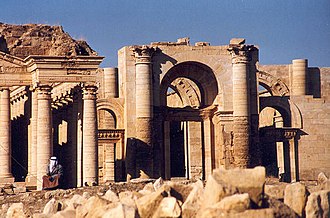Siege and aftermath
Modern sources put the date of Hatra's fall in 240–241 AD (or April 241 AD) per the newly discovered document Cologne Mani Codex (18.2-8), which is the year that Ardashir I crowned his son Shapur I as the co-regent. Either of these may have conquered Hatra. The siege took one year, [1] [2] or two years, according to al-Tabari. [3]
The siege was part of a "forgotten" Roman-Persian war at the second half of 230s. A small Roman garrison was probably stationed in the city, and was most likely destroyed. [4]
After the city's conquest, it was plundered, its fortifications were destroyed, the city was deserted and never resettled, and the Kingdom of Hatra was disestablished. [5] [1] In 363, Ammianus Marcellinus passed by Hatra together with the Roman army and has described it as an "old city situated in an uninhabited area and deserted for a long time past". [1]
The fall of Hatra is described in medieval Arabic and Persian traditions via stories that mix facts and fiction. The legend tells of the Hatrene princess al-Nadirah who betrayed the city to Shapur I after falling in love with him. [1]
The Sasanian capture of Hatra is thought to be the cause of the Persian war of Gordian III. [6]
This page is based on this
Wikipedia article Text is available under the
CC BY-SA 4.0 license; additional terms may apply.
Images, videos and audio are available under their respective licenses.
